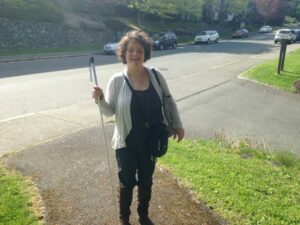
Sometimes when one comes across someone who is blind, partially sighted, or Deafblind, it may be their first time interacting with them. Even if it is not their first time, often one may feel intimidated or worried about the correct or incorrect things they could do when in a particular situation. Not to fear, as this is why I have put together a simple list of etiquette tips one can follow when meeting or approaching someone who is blind.
Speak, speak, and always speak. No matter the situation, using your words is more effective with someone who is blind rather than pointing, or simply grabbing them and moving them around like a doll. If you see a person who is blind or partially sighted who may need assistance, always remember to approach them and ask if they need anything rather than assuming and attempting to grab them. If they cannot see you, they are not able to identify if you are simply trying to be kind or attack them, so they may lash out. Moreover, when giving someone directions, avoid using words such as “over there” and “over here” as that is not descriptive enough for someone who is unable to see. Remember to again speak and think descriptively in order to provide clear and concise directions.
Petiquette. Although it might be tempting to pet a dog when you see them on the street, unfortunately it is never okay to pet a working dog without the handler’s permission. If you see a person who has a guide dog, refrain from petting the dog or giving it food as it can be quite unsafe for both the dog and handler. If you are distracting the dog, they might miss alerting their handler of an obstacle. These highly trained dogs are also on very specific food schedules. Similarly, it is absolutely never okay to grab either the harness handle of a guide dog or a person’s white cane. This is the equivalent to grabbing the steering wheel from a driver and can have serious consequences. Unless there is serious danger, as stated above, use your words and ask first.
Never assume. Just because you have previously met another individual who happened to be blind or partially sighted or Deafblind does not mean the individual you are currently happening to cross paths with is the exact same person as them. Just like a sighted person, individuals with disabilities are just that, individuals. This means that although one person may require assistance, another may not. This can apply to other things as well such as likes and dislikes. Getting to know the person for their individuality is a great way to get a conversation started, rather than comparing them to another blind person you met.
Talk directly to them. Although you may be nervous, or intimidated, it is best to directly speak with the person who is blind rather than speaking to another person they might be with. Whether this is in regards to any questions you may have for them, or asking them what they like to eat, it is always best to talk to them rather than making them feel like they are not in the room. This can actually make things more awkward as you are putting pressure on someone else to know what their friend or family member will like. Simply imagine yourself in the shoes of a minority; you would not want others to tell your story and answer questions people had about you.
How many fingers you should not hold up. Sometimes, as a way of being humorous, or out of a genuine interest to determine a person’s level of remaining vision, someone might ask the all too common question of “How many fingers am I holding up?” However, rather than do this, simply ask the person how much vision they have, and if they are okay with answering it, they will. As for joking about asking how many fingers you are holding up, it can actually be quite offensive if you are aware that the person has little to no remaining vision.